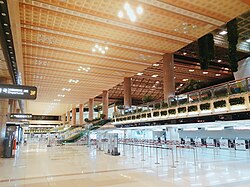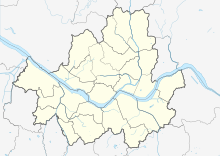Our website is made possible by displaying online advertisements to our visitors.
Please consider supporting us by disabling your ad blocker.
Gimpo International Airport
This article needs additional citations for verification. (July 2009) |
Gimpo International Airport 김포국제공항 | |||||||||||||||
|---|---|---|---|---|---|---|---|---|---|---|---|---|---|---|---|
 Terminal interior in 2019 | |||||||||||||||
| Summary | |||||||||||||||
| Airport type | Public | ||||||||||||||
| Owner | Ministry of Land, Infrastructure and Transport | ||||||||||||||
| Operator | Korea Airports Corporation | ||||||||||||||
| Serves | Seoul Capital Area | ||||||||||||||
| Location | Gonghang-dong, Gangseo District, Seoul, South Korea | ||||||||||||||
| Opened | January 1958 | ||||||||||||||
| Hub for | |||||||||||||||
| Focus city for | T'way Air | ||||||||||||||
| Operating base for | |||||||||||||||
| Built | 1939 | ||||||||||||||
| Elevation AMSL | 18 m / 58 ft | ||||||||||||||
| Coordinates | 37°33′29″N 126°47′26″E / 37.55806°N 126.79056°E | ||||||||||||||
| Website | www | ||||||||||||||
| Maps | |||||||||||||||
 Seoul in South Korea | |||||||||||||||
Location in Seoul | |||||||||||||||
 | |||||||||||||||
| Runways | |||||||||||||||
| |||||||||||||||
| Statistics (2019) | |||||||||||||||
| |||||||||||||||
Statistics from KAC[1] | |||||||||||||||
| Korean name | |||||||||||||||
| Hangul | 김포국제공항 | ||||||||||||||
| Hanja | 金浦國際空港 | ||||||||||||||
| Revised Romanization | Gimpo Gukje Gonghang | ||||||||||||||
| McCune–Reischauer | Kimp'o Kukche Konghang | ||||||||||||||
Gimpo International Airport (IATA: GMP, ICAO: RKSS), sometimes referred to as Seoul–Gimpo International Airport but formerly rendered in English as Kimpo International Airport, is located in the far western end of Seoul, some 15 kilometres (9 mi) west of the central district of Seoul.
Gimpo previously carried the IATA airport code SEL, which is now used by airline reservation systems within the Seoul Capital Area, and was the main international airport for Seoul and South Korea before being replaced by Incheon International Airport in 2001. It now functions as Seoul's secondary airport. In 2015, over 23 million passengers used the airport, making it the third-busiest airport in Korea since being surpassed by Jeju International Airport.
The airport is located south of the Han River in western Seoul. The name Gimpo comes from the nearby city of Gimpo, of which the airport used to be a part.
On 29 November 2003, scheduled services between Gimpo and Haneda Airport in Tokyo resumed with services also operating at Incheon Airport. Services to Shanghai Hongqiao International Airport resumed on 28 October 2007. Services to Kansai International Airport in Osaka, Japan, started on 26 October 2008 with services also operating at Incheon Airport. Services to Beijing Capital International Airport started on 1 July 2011 with services also operating at Incheon Airport.[2] Services to Taipei Songshan Airport started on 30 April 2012.[3]
- ^ 공항별 통계 : 항공통계 : 알림·홍보 : Kac 한국공항공사. Archived from the original on 20 January 2019. Retrieved 20 January 2019.
- ^ Gimpo–Beijing air route to open in July Archived 23 March 2012 at the Wayback Machine. South Korea News (26 April 2011). Retrieved on 12 July 2013.
- ^ Songshan to begin direct flights to Gimpo in Seoul. Taipei Times (30 April 2012). Retrieved on 6 March 2015.
Previous Page Next Page
مطار غيمبو الدولي Arabic Aeropuertu Internacional de Gimpo AST Gimpo International Airport CEB Mezinárodní letiště Kimpcho Czech Flughafen Gimpo German Aeropuerto Internacional de Gimpo Spanish فرودگاه بینالمللی گیمپو FA Gimpon kansainvälinen lentoasema Finnish Aéroport international de Gimpo French נמל התעופה הבין-לאומי גימפו HE




